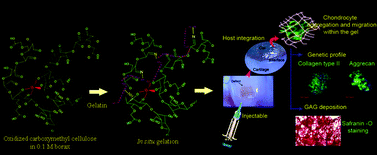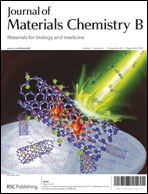Borate aided Schiff's base formation yields in situ gelling hydrogels for cartilage regeneration†
Abstract
Injectable in situ forming, biodegradable and extracellular matrix (ECM) mimicking hydrogels have great possibilities in tissue engineering. Simple and easily translated methods, while circumventing toxicity, stability and scale-up issues, are in great demand for the preparation of these hydrogels. This paper aims to investigate how the borate complexation of oxidized carboxymethyl cellulose (CMC), followed by Schiff's reaction with gelatin without using any extraneous cross-linking agents can lead to the development of injectable, cost-effective, biodegradable ECM mimics for cartilage tissue engineering. Tuning of gelation kinetics and cross-linking density of the system is easily achievable by just adjusting the concentration of components. Hydrogels reveal porous structure, biodegradability and biocompatibility with negligible inflammatory response and minimal reactive oxygen species (ROS) generation. The hydrogel integrates well with host cartilage tissue, thereby stabilizing it and preventing further degeneration, which is essential for osteoarthritis management. Migration of chondrocytes seeded on the surface of the gel to the interior is envisaged as a cell attracting property of the matrix to guide tissue repair in cartilage defects. Chondrocytes exhibit cluster formation within the matrix and support proliferation and functionality. These results support the potential of this hydrogel as an injectable cost-effective matrix for cartilage tissue engineering.


 Please wait while we load your content...
Please wait while we load your content...